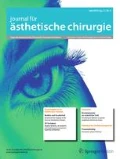Zusammenfassung
Zur Anlage eines Luftröhrenschnitts gibt es zurzeit viele Indikationen und unterschiedliche Vorgehensweisen. Die Regie im Rahmen einer interdisziplinären Indikationsstellung, bei der Auswahl des operativen Verfahrens, bei der Versorgung der tracheotomierten Patienten, insbesondere bei der Behandlung von typischen Problemen am Tracheostoma und von Komplikationen sollte beim HNO-Arzt liegen. Im Notfallmanagement stehen zunächst verschiedene nichtchirurgische Maßnahmen wie die Maskenbeatmung, die Intubation und extraglottische Atemwegshilfen, wie z. B. die Larynxmaske, im Vordergrund. Sollte dies nicht gelingen, ist die Ultima Ratio das translaryngeale und transtracheale Atemwegsmanagement. Hierbei kommen sowohl verschiedene Techniken der Koniotomie, der translaryngealen/transtrachealen Oxygenierung und Ventilation als auch in Einzelfällen die chirurgische Tracheostomie infrage. Unter Berücksichtigung der Kontraindikationen ist die perkutane Dilatationstracheotomie eine Alternative zur chirurgischen Tracheostomie. Aufgrund zahlreicher Kontraindikationen, wie beispielsweise der Indikation für ein dauerhaftes Tracheostoma, anatomischer Schwierigkeiten und fehlender Möglichkeiten zur Intubation oder Tracheobronchoskopie, behält die chirurgische Tracheostomie einen festen Stellenwert im chirurgischen Repertoire.
Abstract
There are currently many indications and established surgical techniques for tracheotomy with a variety of approaches. The interdisciplinary diagnostic evaluation, selection of the procedure, care of tracheotomized patients and in particular the treatment of typical problems and complications should be under the control of an ear nose and throat specialist. In emergency management a wide range of non-surgical procedures, such as bag-valve mask ventilation, endotracheal intubation and extraglottic airway devices (e.g. laryngeal mask) are initially available. If these are unsuccessful, translaryngeal transtracheal airway management is the last resort. In this case various techniques, such as coniotomy, translaryngeal transtracheal oxygenation and ventilation, as well as occasionally surgical tracheotomy can be applied. Taking the contraindications of percutaneous dilatation tracheotomy into consideration this method is a viable alternative to surgical tracheotomy. Due to various contraindications, such as the need for a permanent tracheostomy, anatomical difficulties and the impossibility of intubation or tracheobronchoscopy, surgical tracheotomy remains of fundamental importance in the surgical repertoire.


Literatur
Bartels H (2005) Techniken der Tracheotomie/Tracheostomie. Chirurg 76:507–516
Bast F, Buchal A, Schrom T (2015) Perkutane Dilatationstracheotomie oder Tracheostomie. HNO 63:220–223
Delaney L, Bagshaw SM, Nalos M (2006) Percutaneous dilatational tracheostomy versus surgical tracheostomy, a systematic review and meta-analysis. Crit Care 10:R55
Gray H (1918) Anatomy of the Human Body. Lea and Febiger. Philadelphia and New York
Haspel AC, Coviello VF, Stevens M (2012) Retrospective study of tracheostomy indications and perioperative complications on oral and maxillofacial surgery service. J Oral Maxillofac Surg 70:890–895
Heuer B, Deller A (1998) Früh- und Spätresultate der perkutanen Dilatationstracheostomie (PDT Ciaglia) bei 195 Intensivpatienten. Anaesthesiol Intensivmed Notfallmed Schmerzther 33:306–312
Holdgaard H, Pedersen J et al (1998) Percutaneous dilatational tracheostomy versus conventional surgical tracheostomy. Acta Anaesthesiol Scand 42:545–550
Koitschev A, Graumueller S et al (2003) Tracheostomy in intensive care medicine. Is the ENT specialist still needed? HNO 51:616–620
Koscielny S, Guntinas-Lichius O (2009) Dilatation tracheotomy update: indications, limitations and management of complications. HNO 57:1291–1300
Piepho T, Cavus E et al (2015) S1 Leitlinie: Atemwegsmanagement/Airwaymanagement. AWMF-Register NR.:001/028
Silvester W, Goldsmith D, Uchino S et al (2006) Percutaneous versus surgical tracheostomy: a randomized controlled study with long-term follow-up. Crit Care Med 34:2145–2152
Stripf T, Ali M et al (2003) Percutaneous dilatative tracheostomy versus conventional surgical tracheostomy: a retrospective trial. Laryngorhinootologie 82:281–285
Author information
Authors and Affiliations
Corresponding author
Ethics declarations
Interessenkonflikt
N. Czerwinski und H. Behrbohm geben an, dass kein Interessenkonflikt besteht.
Dieser Beitrag beinhaltet keine Studien an Menschen oder Tieren.
Additional information
Dieser Artikel basiert auf einem Vortrag bei der Jahrestagung 2016 der Gesellschaft für Ästhetische Chirurgie (GÄCD) in Köln.
Rights and permissions
About this article
Cite this article
Czerwinski, N., Behrbohm, H. Tracheostomie versus perkutane Dilatationstracheotomie. J Ästhet Chir 9, 6–8 (2016). https://doi.org/10.1007/s12631-015-0031-2
Published:
Issue Date:
DOI: https://doi.org/10.1007/s12631-015-0031-2

